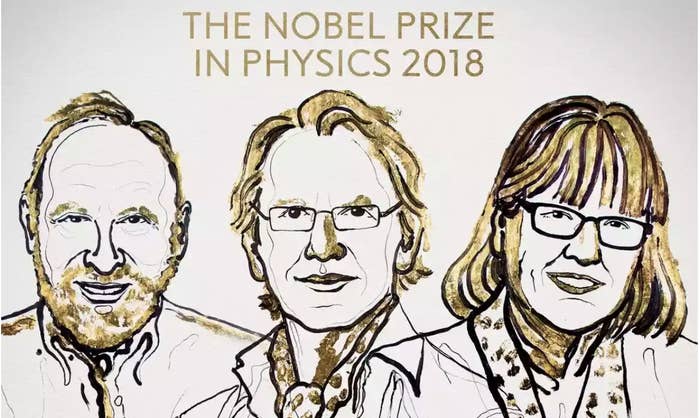
The invention of powerful laser tools has won the Nobel Prize in Physics for 2018, jointly awarded to scientists from the US, Canada, and France.
The Royal Swedish Academy of Sciences awarded half of the $1 million prize Tuesday to Arthur Ashkin, 96, of Bell Laboratories in the US for “groundbreaking inventions in the field of laser physics,” the 1987 development of laser tweezers that manipulate objects on the molecular scale.
Arthur Ashkin, awarded the 2018 #NobelPrize, had a dream: imagine if beams of light could be put to work and made to move objects. He realised his dream by creating a light trap, which became known as optical tweezers. https://t.co/6W6juINq5f
The other half was split between Gérard Mourou of France’s École Polytechnique and Donna Strickland of Canada's University of Waterloo, who in 1985 invented a way to make high-intensity laser pulses now used in eye surgery and many other applications.
Ultra-sharp laser beams make it possible to cut or drill holes in various materials extremely precisely – even in living matter. Millions of eye operations are performed every year with the sharpest of laser beams. #NobelPrize https://t.co/MiYb4i8AHw
“Well, first you have to think you're crazy,” Strickland said at a Nobel committee news conference by phone, on winning the prize. She is the third woman to be awarded a physics Nobel. “I thought there would be more,” she said.
This year's prize is noteworthy in honoring inventions, the award committee noted, not theoretical physics or astrophysics breakthroughs seen in some past years. The laser was invented in 1960, and this year’s prize recipients pioneered advances that have helped make these coherent beams of light one of the signature and ubiquitous technologies of the modern era.
“The prizes show how science and technology that people may not have even heard about is changing lives for the better,” Michael Moloney of the American Institute of Physics told BuzzFeed News. “While these winners may not have been on the top of everyone’s mental list of likely picks, they are very well-regarded by the field.”

Ashkin realized a dream of science fiction, moving and pinning objects with light, in a series of experiments that showed viruses and bacteria moved to the center of a laser light beam, where it was most intense. He first captured bacteria in these light traps, in an accidental discovery, in 1987.
He was reportedly too busy working on his next experiment to phone in to the prize announcement news conference. Ashkin has focused on using optical tweezers to study viruses and bacteria, most notably investigating the “molecular motors” that allow bacteria to move themselves around.
Mourou and Strickland tackled another challenge for lasers, creating powerful light pulses of short duration without burning out the lasers themselves. In her doctoral work for Mourou at the University of Rochester, Strickland created a workaround for this problem, which had stymied the laser field, by creating what is called “chirped pulse amplification.”
The technique first stretches out short light pulses, then amplifies the stretched pulse, and finally compresses this more powerful burst of light back together. It can now create powerful laser pulses that last for femtoseconds (one millionth of a billionth of a second), allowing for extremely precise laser beams to conduct eye surgery and machine tools to otherwise impossibly fine specifications.
“Everyone who has had laser eye surgery owes it to chirped pulse amplification; it's one of the keys to our world today,” Moloney said.
The last woman to win a Nobel Prize in Physics was Maria Goeppert-Mayer in 1963, who followed Marie Curie in 1903. Curie's prize made worldwide headlines and had put the Nobels in the public eye as the most prestigious prize in science. The award committee in its announcement noted that more nominations were coming for women in recent years, and it hoped to see more such prizes soon.
👀 https://t.co/7gpUqOgQtR
On Twitter, some observers raised questions about how Strickland, a Nobel prize–caliber physicist, wasn't a full professor after three decades as a researcher, but only an associate professor. “She is an associate professor, but she does have tenure,” Matthew Grant of the University of Waterloo told BuzzFeed News.
